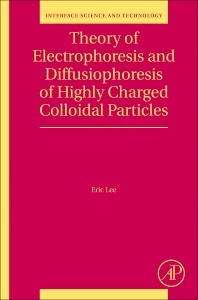Theory of Electrophoresis and Diffusiophoresis of Highly Charged Colloidal Particles Interface Science and Technology Series
Auteur : Lee Eric

Part I. Electrophoresis of Rigid Particles 1. Polarization of Electrical Double Layer of a Highly Charged Spherical Particle 2. Concentrated Suspensions of Particles and Double Layer Overlapping 3. The Motion of a Particle Near a Solid Plane 4. The Motion of a Particle Near an Air-Water Interface 5. The Motion of a Particle Through a Cylindrical Pore 6. Dynamic Electrophoresis
Part II. Soft Particles and Porous Media 7. Behaviors in a Concentrated Suspension 8. Boundary Effects with a Nearby Solid Plane or Air-Water Interface 9. Particle Motion Through a Cylindrical Pore and Applications 10. Dynamic Electrophoresis of Soft Particles 11. Gel-Electrophoresis in Suspensions and Near Planar Boundaries
Part III. Liquid Drops 12. Behaviors in a Concentrated Suspension 13. Impact of Nearby Planar Boundaries 14. Motion Through a Cylindrical Pore 15. Dynamic Electrophoresis of Liquid Drops
Part IV. Diffusiophoresis 16. Behaviors in Concentrated Suspensions of Rigid Particles 17. Particle Motions with Nearby Boundaries and Potential Applications in Microfluidics 18. Behaviors of Nonrigid Particle Systems
Scientists in academia and industry, chemical engineers, and graduate students in surface and colloid chemistry who need to understand the electrokinetic behavior of highly charged particles
- Provides a reliable quantitative prediction of highly charged particles motion with easy-to-apply charts and in-depth understanding of the underlying mechanisms
- Offers an extensive treatment of direct quantitative predication for non-rigid systems, such as porous particles, liquid drops, and gels, which is especially valuable in proteins and DNA research
- Discusses highly charged systems with a nearby boundary of practical interests, such as a pore, a solid plane, or an air-water interface, which is of vital interest in fields such as microfluidic operations and biomedical engineering
- Affords special attention to the polarization effect
Date de parution : 12-2018
Ouvrage de 436 p.
15x22.8 cm



